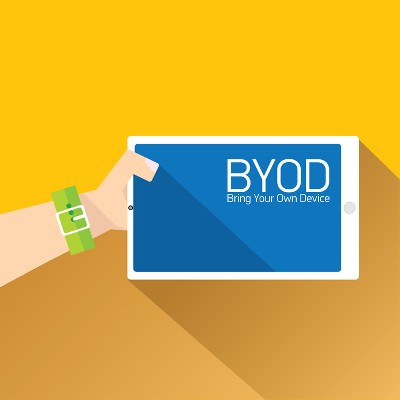Businesses are always trying to improve on efficiency, and one method they use to do so is mobile technology. Businesses invest in mobile technology like smartphones, laptops, and data plans for their employees with the expectation that it will help them be more productive, but the fact of the matter is that these investments are costly for the return. There is another approach businesses use: Bring Your Own Device, or BYOD, and it’s a great way to save capital while achieving the same levels of productivity from mobile technology.
USA Computer Services Blog
Organizations are always trying to get more efficient. One way that businesses are able to accomplish this is by utilizing mobile computing. This used to mean that businesses would have to spend a bunch of money purchasing phones, data plans, and the like for their employees. Some time ago, businesses started to realize that they could improve their mobile strategies without this massive expense by enacting a BYOD policy. Let’s discuss what a BYOD policy is and how it does more than just save a business money.
Network security is not the easiest thing to implement for your business, and you definitely need someone trained in this topic to be the one behind the wheel. Thankfully, the correct solutions can make this much easier to pull off. Here are some of the best and most important security solutions you should be considering for your organization.
Bring Your Own Device has a lot of benefits for businesses, chief among them being giving your users the opportunity to use their own devices for work rather than those provided to them. More often than not, they will benefit from easy-to-use apps on their preferred devices, allowing them to get more done throughout the workday. When you implement BYOD, though, there are various concepts that you have to consider in order to ensure productivity, flexibility, security, and profitability.
Mobile devices are one of the greatest tools available for business use today. However, because society has come to rely so much on mobile devices, these devices have become a treasure trove for cybercriminals to obtain information from. For this week’s tip, we’ll go over some simple ways to protect yourself from such threats.
For the modern business, having a strategy to manage your employees smartphone use is essential. This is because most of the people that work for you have smartphones. One study shows that upwards of 90 percent of people under 30 own a smartphone. If you have any design on running a business, or employing millennials (who are the largest generation in the current workforce), you’ll need to know what you are doing to protect your business from the increasing amount of threats that are out there targeting smartphones.
Google’s Android line of smart devices have made their presence well-known in the business world. Google now offers a zero-touch enterprise solution for its Pixel-line mobile devices. The primary reason for this is that mobile devices are somewhat time-consuming to set up, especially on the business level. You can save time by pre-configuring these devices for your business to use using Pixel’s zero-touch solution.
Bring Your Own Device, or BYOD, continues to grow into one of the most accepted practices within an organization. Yet, one major problem has always plagued BYOD in the form of security. Thankfully, with the help of mobile device management, businesses are able to minimize this risk while leveraging the benefits that BYOD offers.
 Some businesses embrace Bring Your Own Device (BYOD) policies in the workplace, while others aren’t so sure. If you think that employers are the only ones worried about BYOD policies, you might be surprised to learn that employees are just as concerned about it as their employers. Of course, their reasons are entirely different, but are still valid reasons to be on edge.
Some businesses embrace Bring Your Own Device (BYOD) policies in the workplace, while others aren’t so sure. If you think that employers are the only ones worried about BYOD policies, you might be surprised to learn that employees are just as concerned about it as their employers. Of course, their reasons are entirely different, but are still valid reasons to be on edge.
 Just for one second, try to imagine your life without your personal mobile device. Mobile devices has pervaded our very existence, and they are integral tools for connecting to your business’s network. But even with this colossal amount of data on the device, some people still manage to lose them. What would happen if your smartphone fell into the hands of one of your competitors, or even a hacker?
Just for one second, try to imagine your life without your personal mobile device. Mobile devices has pervaded our very existence, and they are integral tools for connecting to your business’s network. But even with this colossal amount of data on the device, some people still manage to lose them. What would happen if your smartphone fell into the hands of one of your competitors, or even a hacker?
 Two hot trends in the business technology industry are companies going Green (adopting environmentally savvy work environments), and implementing Bring Your Own Device (BYOD) system for your office. In reality, these two trends go hand in hand, as they seek to use technology to increase efficiency in the everyday operation of businesses worldwide. Here's how to implement your company's Green campaign with BYOD.
Two hot trends in the business technology industry are companies going Green (adopting environmentally savvy work environments), and implementing Bring Your Own Device (BYOD) system for your office. In reality, these two trends go hand in hand, as they seek to use technology to increase efficiency in the everyday operation of businesses worldwide. Here's how to implement your company's Green campaign with BYOD.
 One of the hottest trends in business technology is having employees bring in their personal devices to the office for work purposes. This trend is commonly referred to as BYOD (Bring Your Own Device), and before you blindly follow the trend and allow BYOD for your business, you should first weigh the benefits against the risks.
One of the hottest trends in business technology is having employees bring in their personal devices to the office for work purposes. This trend is commonly referred to as BYOD (Bring Your Own Device), and before you blindly follow the trend and allow BYOD for your business, you should first weigh the benefits against the risks.








